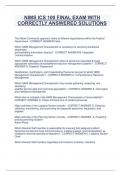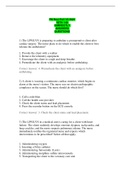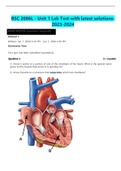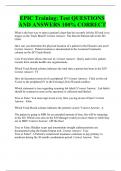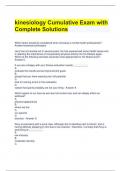ARTICLE 1: KATSIKAS ET AL. 2016 – ASSESSING PERFORMANCE OUTCOMES IN MARKETING............................4
ARTICLE 2: KIRCA ET AL. 2005 – MARKET ORIENTATION: A META- ANALYTIC REVIEW AND ASSESSMENT OF ITS
ANTECEDENTS AND IMPACT ON PERFORMANCE............................................................................................5
ARTICLE 3: HILLEBRAND ET AL. 2015 - STAKEHOLDER MARKETING: THEORETICAL FOUNDATIONS AND
REQUIRED CAPABILITIES................................................................................................................................. 7
ARTICLE 4: RUST ET AL. 2001 – DRIVING CUSTOMER EQUITY: LINKING CUSTOMER LIFETIME VALUE TO
STRATEGIC MARKETING DECISIONS................................................................................................................ 9
ARTICLE 5: LEROI- WERELDS ET AL. 2014 – ASSESSING THE VALUE OF COMMONLY USED METHODS FOR
MEASURING CUSTOMER VALUE: A MULTI-SETTING EMPIRICAL STUDY..........................................................11
ARTICLE 6: KUMAR 2018 - A THEORY OF CUSTOMER VALUATION: CONCEPTS, METRICS, STRATEGY AND
IMPLEMENTATIONS...................................................................................................................................... 13
ARTICLE 7: PALMATIER ET AL. 2006 – FACTORS INFLUENCING THE EFFECTIVENESS OF RELATIONSHIP
MARKETING: A META-ANALYSIS................................................................................................................... 15
ARTICLE 8. VERMA ET AL. 2015 - RELATIONSHIP MARKETING IN ONLINE RETAILING......................................17
ARTICLE 9. HOMBURG ET AL. 2015 - MEASURING AND MANAGING CONSUMER SENTIMENT IN ONLINE
COMMUNITY............................................................................................................................................... 19
ARTICLE 10: BALDUCCI ET AL. 2018 – UNSTRUCTURED DATA IN MARKETING.................................................21
ARTICLE 11: COLICEV ET AL. 2018 - IMPROVING CONSUMER MINDSET METRICS AND SHAREHOLDER VALUE
THROUGH SOCIAL MEDIA: THE DIFFERENT ROLES OF OWNED AND EARNED MEDIA......................................23
ARTICLE 12: RUST ET AL. 2021 – REAL-TIME BRAND REPUTATION TRACKING USING SOCIAL MEDIA...............25
ARTICLE 13. LUO ET AL. (2021) - AI COACHES FOR SALES AGENTS: CAVEATS AND SOLUTIONS........................27
ARTICLE 14: HOMBURG ET AL. 2015 - MEASURING AND MANAGING CONSUMER SENTIMENT IN AN ONLINE
COMMUNITY ENVIRONMENT....................................................................................................................... 29
1
, First, The chain of marketing performance outcomes
The chain of marketing performance outcomes, as depicted in the diagram and explained in the article, outlines
the steps through which a firm's marketing resources, strategies, and actions translate into organizational
performance. Here's a simplified explanation:
1. Firm’s Marketing Resources, Strategy, and Actions: It starts with the firm’s marketing capabilities and
strategic initiatives. These resources and strategies are directed into the marketplace through realized
marketing programs.
2. Realized Marketing Programs: These are the actual marketing activities that firms implement based
on their strategies. They are designed to impact the market and engage with customers directly.
3. Customer Mindset: The next stage is how these programs influence the customer's perceptions. This
includes building brand equity, perceived quality, satisfaction, and loyalty.
4. Customer Behavior: Positive customer mindsets lead to favorable behaviors such as acquisition
(gaining new customers), retention (keeping existing customers), and word-of-mouth (customers
sharing positive experiences).
5. Customer-Level Performance: These customer behaviors result in measurable outcomes like share of
wallet (proportion of customer spending with the firm), profitability, and customer lifetime value.
6. Product-Market Performance: This encompasses market-level outcomes such as unit sales, revenue
premium, market share, and the success of new products, showing how the firm's offerings perform in
the market.
7. Accounting Performance: At this stage, the firm's marketing efforts translate into financial metrics
such as sales revenue, profit, and cash flow, which are reported in the firm's financial statements.
8. Financial-Market Performance: Finally, these accounting outcomes influence financial market
performance indicators such as investor returns, equity risk, and credit ratings, reflecting the firm's
overall financial health in the eyes of investors and stakeholders.
The process is dynamic, involving learning and reinvestment:
Learning: Firms adapt and refine their strategies based on outcomes at each stage.
Reinvestment: Profits generated are reinvested back into marketing and other resources to sustain
and grow performance over time.
This chain illustrates how marketing activities are linked to broader business and financial outcomes,
emphasizing the importance of integrating marketing with firm strategy and operations for sustained success
2
,3
,Article 1: Katsikas et al. 2016 – assessing performance outcomes in marketing.
What is the main finding regarding Studies on marketing performance often use different methods to
Marketing Performance? measure success, making it hard to compare results. Many studies
treat performance as a latent construct or as a hidden variable
without showing the relationships between different indicators. This
inconsistency makes it difficult to compare findings between studies.
The authors suggest that a clear and consistent method is needed to
measure marketing performance for better comparison and
understanding in future research.
What is Operational Performance Operational performance refers to the outcomes of a company’s
and what are the 4 elements that marketing efforts and other business activities in terms of efficiency
are related to it? and effectiveness. The four elements related to it are:
Customer Mindset: Customer attitudes and perceptions toward the
company and its offerings.
Product Market Performance: Success of products in the market,
including sales and market share.
Customer Behavior: Actions like purchases, loyalty, and word of
mouth.
Customer-Level Performance: Economic outcomes from individual or
groups of customers, such as customer lifetime value (CLV).
What is Organizational Organizational performance refers to the overall financial outcomes
Performance and what are the 2 and results that a company achieves through its operations and
elements that are related to it? marketing efforts. It focuses on the broader, firm-level results. The two
elements related to it are:
Accounting Performance: Financial measures such as profit, return on
assets (ROA), and revenue.
Financial-Market Performance: How the company’s value is reflected
in stock prices, shareholder returns, or credit ratings.
What is meant by 'share of wallet' 'Share of wallet' means how much money a customer spends at one
and to which element does this company compared to what they spend at other companies in the
term belong to? same category. For example, if someone buys groceries, 'share of
wallet' shows what percentage of their total grocery spending goes to
one store. This term is part of Customer-Level Performance, which
looks at the financial value a company gets from its customers.
Which aspects have dominated Accounting Performance: This includes financial measures like profit,
previous research on performance return on assets (ROA), and revenue.
outcomes?
Product-Market Performance: This involves measures like market
share and sales figures, showing how products perform in the market.
4
,Article 2: Kirca et al. 2005 – Market orientation: a meta- analytic review and assessment
of its antecedents and impact on performance
What is the main finding regarding The main finding is that market orientation positively impacts a
Marketing Orientation? company's performance. The study shows that when companies
focus on understanding and meeting customer needs (market
orientation), they tend to perform better in terms of sales, profit,
and overall business success. It highlights that top management
support, interdepartmental collaboration, and reward systems play a
key role in making market orientation effective.
What is the Marketing Concept? The marketing concept is the idea that a company achieves success
by identifying and meeting customer needs better than its
competitors. It emphasizes that the primary focus of the company
should be on understanding customer preferences and delivering
products or services that satisfy those needs to maintain a
competitive advantage and achieve long-term success.
What is the connection between Market orientation is positively linked to organizational
Market Orientation and performance. This means that when a company effectively
Organizational Performance understands and responds to customer needs (market orientation),
it generally sees improvements in its performance metrics, such
as sales growth, profit, and overall business success.
The study also notes that this relationship is stronger
in manufacturing firms and in cultures with low power
distance and low uncertainty avoidance.
What are the most important Top Management Emphasis: Leaders need to prioritize and promote
aspects of the implementation of a market-oriented approach within the organization.
Market Orientation
Interdepartmental Connectedness: Different departments must
work together, share information, and collaborate effectively.
Market-Based Reward Systems: Employees should be rewarded for
behaviors and actions that support market orientation, such as
understanding and meeting customer needs.
5
, 6



